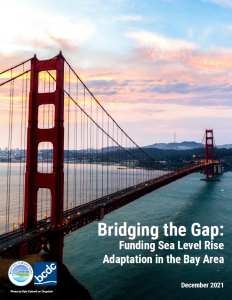Rising sea levels (SLR) will have widespread impacts on the Bay Area, and adapting to this hazard will cost tens of billions of dollars over the next several decades. This paper is an initial exploration of forecasted estimated damages in the absence of adaptation, as well as the funding needs, funding supplies, and funding gaps that the region could face as it adapts to rising sea levels during this century. It is apparent that multiple funding sources – a diverse set of public funding mechanisms as well as private and philanthropic funding – will be required for the Bay Area to adequately address this problem. This exploration is based on what we know now. But, there is so much uncertainty surrounding the “how,” “when,” and “where” of SLR that this exploration needs to be viewed against the kaleidoscope of so many issues that are based on forecasts that, themselves, can be viewed as uncertain.
First, some salient facts:
- The 2018 California Ocean Protection Council (OPC) State guidance on SLR forecasts 2’ feet of SLR by 2050 and 6.6’ feet of SLR by 2100 as a likely possibility in its Medium-High Risk aversion scenario.
- The remaining wetlands in the Bay Area are at the risk of being lost due to SLR by 2100. These critical ecosystems provide many benefits including habitats, biodiversity, stormwater retention, wave attenuation, carbon sequestration and recreation.
- USGS economic property damage estimates caused by around 3′ of SLR with a 1-year storm in the Bay Area is $55.8 billion, which is comparable to Superstorm Sandy at $55.6 billion. The estimate resulting from about 6′ of SLR with a 1-year storm in the Bay Area is $118.8 billion, putting it in the ballpark of Hurricane Katrina at $144 billion.
- Regional costs for adapting to 2′ of SLR are around $19 billion (Metropolitan Transportation Commission/Association of Bay Area Governments), while adapting to 6′ of SLR could cost around $146 billion (UC Berkeley).
- This paper projects a hypothetical funding supply range of between $63.7 million and $318.5 million per year that may be allocated or raised for Bay Area SLR adaptation efforts based on recent city expenditure and revenue data collected by the State Controller’s Office (SCO).
- The estimated needs and existing funding supply result in a funding gap in the 9-County Bay Area of roughly $315 million to $570 million per year to protect against 2’ of SLR (2050), and $1.5 billion to $1.76 billion per year to protect against 6.6’ of SLR (2100). This funding gap estimate will change, and may change dramatically, as the region undertakes more detailed risk analysis. These are only estimates based on existing information collected from a wide variety of sources.
Project Status
This white paper was completed in Fall 2021. The paper can be downloaded below.
Findings and Materials
Related Projects
Project Partners
Special thanks to Nicolas Sander, Dana Brechwald, Jessica Fain, Larry Goldzband, Brenda Goeden, Jaclyn Perrin-Martinez, Daniel Hossfeld (Bay Conservation & Development Commission); Sam Cohen (former Bay Conservation and Development Commission); Robert Spencer (Urban Economics); Mark Northcross (NHA Advisors LLC); Brad Benson (Port of San Francisco); Sandra Hamlat, Adam Verat (City and County of San Francisco); Sarah Minick (San Francisco Public Utilities Commission); Brian Benn (Environmental Risk & Financial Solutions); Kathleen Schaefer (P.E., CFM); Jessica Ludy (U.S. Army Corps of Engineers); Rachael Hartofelis, Michael Germeraad (Association of Bay Area Governments & Metropolitan Transportation Commission).

For more information:
- Nicolas Sander
- Nicolas.sander@bcdc.ca.gov
